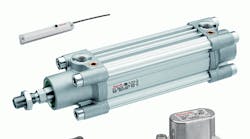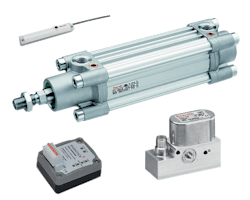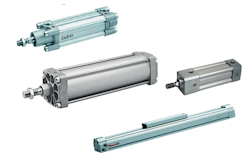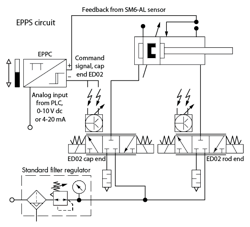This file type includes high resolution graphics and schematics when applicable.
When programming and executing high-speed automation, accuracy in motion sequences—particularly endpoint accuracy—is crucial to manufacturing speed, throughput, and quality. Every movement within a motion sequence must be precise; not only in its positioning, but also in its timing.
Electromechanical positioning is the most common way to accomplish this task in automation systems. In electromechanical systems, linear devices (e.g., profiled rails, ball screws, and linear modules driven by electric motors) lift, move, and place components. These systems can provide excellent positioning accuracy. However, some inherent drawbacks may, in time, increase overall manufacturing costs and affect productivity.
An alternative to electromechanical positioning that’s gaining popularity is electropneumatic positioning. Electropneumatic systems use electrically operated valves to control air flow or pressure to move an actuator to the required location.
In many cases, numerous advantages are associated with pneumatic positioning, including greater productivity, better repairability, and lower total cost of ownership. Pneumatic actuation systems also provide engineers with a number of implementation options, letting them select the best design for a given task.
Electromechanical vs. pneumatic
Accurate positioning refers not only to an actuator’s endpoint accuracy, but also to the accuracy of its position at any selected point along a path of motion. Although endpoint accuracy is important, positioning control throughout a motion sequence is often the desired goal. A positioning system should be able to find and maintain the required position anywhere along its stroke length.
With the advent of high-speed production systems across many industries, automation engineers now focus more than ever on finding cost-effective, energy-efficient positioning-control technologies that improve accuracy. Electromechanical positioning can meet these requirements. However, over the long term, certain aspects of electromechanical technology can lead to higher costs and cause production problems.
For example, electromechanical-positioning systems can heat up and undergo temperature-related changes as well as wear and tear. That, in turn, requires significant downtime to cool. In fact, lower-cost systems often are only capable of 50% duty cycles, spending as much time off as they spend working. Pneumatic-positioning systems, on the other hand, do not include mechanical parts that can overheat. This permits a 100% duty cycle with components that stay cool and can work around the clock.
Also, pneumatic-positioning systems are often more energy-efficient. For instance, electromechanical systems consume electricity simply to hold a position. And without power, electromechanical systems reset themselves, losing any previous work leading up to a power outage. Productivity suffers as a result.
Pneumatics doesn’t have this problem. When designs use pneumatic flow control, a valve in the center position blocks airflow in either direction and the cylinder piston automatically stays put. In the event of power loss to a production system or plant, it’s much easier to restart the operation with pneumatic-positioning systems. Proportional pressure control and normally closed valves provide the same benefits when power is lost.
In addition, pneumatic components are relatively easy and economical to repair. When pneumatic cylinders break or wear out, they can be repaired or replaced at a low cost. On the other hand, when an electromechanical system has issues, it typically requires an expensive new electric drive.
These advantages, combined with the inherent low-maintenance nature of pneumatic devices, create a significantly lower true cost of ownership versus an electromechanical setup. In fact, the cabling alone on an electromechanical device can cost more than an entire pneumatic system.
Pneumatic positioning
Pneumatic-powered actuation provides a proven method for accurate and reliable positioning. Most pneumatic-positioning systems, which combine control valves, cylinders, and simple sensors, rely on directional flow control to control positioning. Such a system monitors piston position feedback and decides the direction air needs to flow to achieve the desired position. Shifting a valve and allowing compressed air flow into the proper cylinder port extends the actuator to the required position. Reversing the valve retracts the cylinder in the opposite direction.
This type of system provides a broad range of directional flow control, translating to precise, incremental positioning control. The valves for such a system are selected based on the bore and stroke of the pneumatic actuator. In general, control of air flow can range from 0 to 1000 lpm.
Still, some drawbacks hinder the use of pneumatic flow control for positioning. The most common concern is associated with a basic limitation of pneumatics: Such systems cannot be perfectly sealed, and an incremental or intermittent loss of air and pressure is unavoidable.
With directional flow control, minor leaks cause the pneumatic cylinder piston to move slightly. The positioning system’s controller receives motion feedback from the sensor, and the controller responds by slightly adjusting flow to compensate for piston movement. This slight but constant back-and-forth motion, known as dithering, negatively affects system accuracy and functionality.
Proportional pressure positioning
Responding to concerns about positioning accuracy and dithering, engineers at AVENTICS developed a system that relies on direct-acting proportional control of air pressure—rather than directional flow control—to improve the precision of pneumatic-positioning systems.
The cost-effective design integrates control electronics with a range of standard pneumatic valves, cylinders, and actuators. But it differs from directional flow-control setups in that it uses direct-acting proportional pressure regulators to constantly monitor and adjust pneumatic pressure. That, in turn, permits precise control of cylinder positioning.
The electropneumatic positioning system (EPPS) uses two proportional pressure regulators mounted on the pneumatic cylinder, one on either side of the cylinder piston. One side maintains a constant pressure using the first proportional pressure regulator (E/P valve), while the second E/P valve controls pressure on the opposite side.
The unit’s electropneumatic positioning controller (EPPC) receives data from, and sends analog pressure command signals to, the proportional pressure regulators. The controller compares the pressure ratio of one side to the other. A proportional-integral-derivative (PID) loop delivers an analog output to the second proportional pressure regulator to adjust the pressure as needed. Greater pressure on the second side means the piston will move forward, and vice versa.
The main advantage of this method is enhanced accuracy. Proportional pressure regulators constantly and precisely control the pressure, eliminating effects of dithering. The direct-acting pneumatic pressure regulators can control pressure within 0.10 psi, and the EPPS system can use any of the company’s pneumatic actuators. As a result, system designers have much more flexibility.
Note that every actuator has different physical characteristics. Therefore, it’s difficult to make a broad statement regarding positional accuracy. However, with a properly selected actuator and optimized tuning of the controller, ±1-mm positioning accuracy is certainly possible. This is better than traditional flow-controlled pneumatic positioning.
Economical precision
While electromechanical and flow-based electropneumatic systems offer effective positioning capabilities, direct proportional pneumatic-control systems such as the EPPS maintain a number of inherent advantages.
The EPPS is designed to economically deliver the benefits of pneumatic positioning to a broad range of automation applications. The system uses standard, off-the-shelf components that are easy to integrate, and they can be quickly replaced when needed. The EPPS integrates an AVENTICS SM6-AL (Hall Effect) sensor, and does not require the cylinder piston rod to be gundrilled as in traditional pneumatic systems. By eliminating gundrilling, standard cylinders can be used, thus reducing cost and delivery time.
Although it relies on electronic controls, the EPPS does not require complex programming. A user simply inputs an analog position command, saving time and resources. Standard analog command for stroke set-point is 0 to 10 V dc or 4 to 20 mA.
In general, electropneumatic systems are more durable than electromechanical systems because they do not require electric motors or drives at the actuator. As a result, they can withstand harsh conditions such as temperature extremes, dusty conditions, and wet and dirty environments.
This file type includes high resolution graphics and schematics when applicable.
Finally, the EPPS improves positioning accuracy compared to conventional pneumatic positioning, and it eliminates drawbacks like the dithering associated with flow-based pneumatic positioners. For many automation applications requiring proven performance, high throughput, and ultraprecise positioning accuracy and control, the EPPS offers a viable alternative to electromechanical and flow-based positioning systems.
Steve Vincent is Product Manager and John Bridges is Marketing Manager for Aventics Corp., Lexington, Ky. For more information, call (859)254-8031 or visit www.aventics.com.





